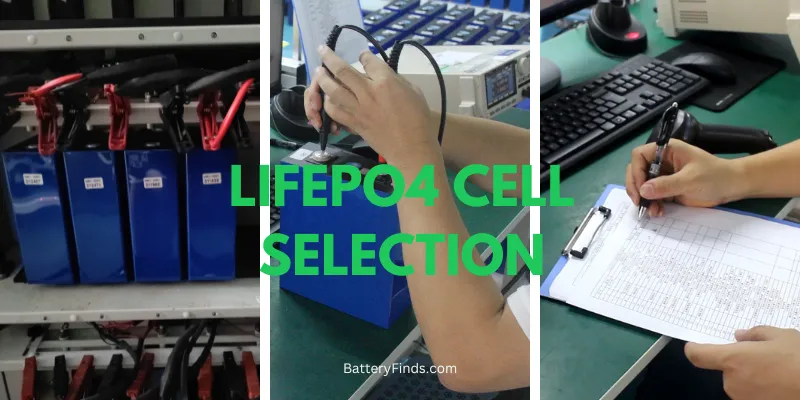LiFePO4 battery matching is the process of combining multiple cell monomers into a battery pack. The following is an overview of the general requirements for LiFePO4 battery matching.
During pack configuration, battery cells with similar performance characteristics should be selected. This includes matching parameters like voltage, capacity, internal resistance, etc. Using cells with comparable features improves the balance and consistency of the pack.
Ensure the cells come from the same production batch or have similar manufacturing parameters. This minimizes performance differences due to manufacturing variances.
The cell properties should meet design requirements such as nominal voltage, capacity, maximum charge/discharge current, etc.
For example, a common cell nominal voltage is 3.2V, and capacity can be chosen as needed, with 100Ah cells being typical.

The battery cells in the pack should have similar capacities. Capacity matching ensures the total pack capacity meets the expected energy storage and release needs. Charge/discharge testing is commonly used to evaluate and match cell capacities.
When capacity matching, charge/discharge testing can determine the actual capacity of each cell for matching purposes.
The tolerance range for capacity matching is usually defined during design to ensure performance consistency during use.
A typical capacity matching tolerance is ±5%. For a 100Ah cell, the range would be 95-105Ah.
The capacity of each cell can be measured via testing and matched accordingly.
For example:
of Cell | Capacity (Ah) |
|---|---|
The battery cells in the pack should have similar voltage characteristics. Voltage matching ensures balanced pack voltages during charge/discharge and prevents overloading cells due to voltage differences.
Voltage matching aims to ensure balanced voltage distribution among the cells in the pack. A common tolerance is ±0.05V.
The voltage of each cell can be monitored by the BMS and adjusted/balanced as needed.
For example:
of Cell | Voltage (V) |
|---|---|
The battery cells should have similar internal resistance properties. This ensures balanced current distribution in the pack during charge/discharge and prevents issues like overheating from resistance differences.
Resistance matching aims to ensure balanced current distribution, minimizing power losses and temperature increases.
Resistance is typically tested via AC impedance spectroscopy or constant current discharge tests. Cells can be categorized and matched based on results.
The tolerance for resistance matching is commonly ±5%. By testing, the internal resistances of cells can be measured and matched.
For example:
of Cell | Internal Resistances (mΩ) |
|---|---|
The temperature must be controlled during the configuration process to ensure the battery cells are configured within appropriate temperature ranges. Temperature has significant impacts on battery performance and lifespan, so overly high or low temperatures should be avoided.
Ensure the configuration process occurs within suitable temperature ranges, typically 15-30°C.
Use temperature sensors to monitor the ambient temperature and take necessary cooling measures to maintain proper temperature ranges.
Balanced charge/discharge via the Battery Management System (BMS) is a key step in the process. The BMS can monitor the voltage, capacity, and temperature of each cell and perform balanced charge/discharge as needed.
During charging, the BMS can adjust the charge current or use active balancing techniques to maintain consistent states of charge across the cells.
During discharging, the BMS can monitor the discharge voltage and capacity of each cell and adjust the load or use active balancing to maintain consistency.
The battery cells in the pack should undergo balanced charge/discharge to ensure consistent cell state. Balanced charge/discharge is typically achieved via the Battery Management System (BMS), which monitors and controls the charge/discharge of each cell.
Balanced charge/discharge via the BMS is a critical step in the configuration process. The BMS can monitor the voltage, capacity, and temperature of each cell and perform balanced charge/discharge as needed.
During charging, the BMS can adjust the charge current or use active balancing techniques to maintain a consistent state of charge across the cells.
During discharging, the BMS can monitor the discharge voltage and capacity of each cell and adjust the load or use active balancing to maintain consistency.
Properly matching LiFePO4 cells is vital for building high-performance, safe DIY battery packs. Carefully follow the recommended requirements for matching cell selection, capacity, voltage, resistance, temperature, and charge/discharge. Investing time into proper cell matching helps ensure your custom LiFePO4 pack will operate optimally for years. With careful matching, even novice builders can successfully construct DIY packs to meet their specific energy storage needs.